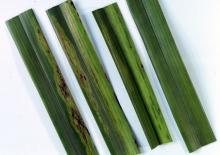Cause There are over 27 viruses reported to infect orchids. The two most important are cymbidium mosaic virus, which has been found to infect 56 genera of orchids, and odontoglossum ringspot virus (formerly the orchid strain of tobacco mosaic virus), which has been reported from 20 orchid genera. Mixed infections of both viruses are common. Both viruses are transmitted by means not involving a vector: mechanical inoculation, division of infected plants, and contact between infected and healthy plants. A contaminated knife used in propagation or cutting flowers will transmit viruses to healthy plants. These viruses are resistant to degradation for long periods on tools and in the soil. These diseases are systemic: virus particles are in roots, bulbs, leaves, and flowers. Once infected, plants cannot be cured. The viruses are not known to be transmitted by seed.
Symptoms Cymbidium mosaic virus-on cymbidiums, symptoms appear first on new growth 6 weeks after infection as small, inconspicuous, elongate, chlorotic areas. Symptoms become more pronounced when light and dark green areas eventually become evident. Brown streaks may appear after 3 to 4 months. On Cattleya leaves, sunken, brown to purple streaks or flecks appear; in severe cases, older leaves drop prematurely. Flowers of cattleya-type orchids develop brown necrotic streaks or necrosis 5 to 21 days after they open and are most noticeable on white or lavender flower types. Symptoms on Phalaenopsis appear on new leaves as yellow, oval or elongated streaks or spots that may look water soaked. These turn purple-black and sunken with age. Lesions usually are only on the lower leaf surface. Vanda leaves develop chlorotic flecks.
Odontoglossum ringspot virus-causes flower color-breaking (especially in the flowers of lavender cattleyas), chlorotic streaking, mosaic, or necrosis. It is symptomless in some cultivars. Oncidium flowers show no symptoms, but mature leaves develop round to irregular, slightly sunken yellow areas on both leaf surfaces. Spots darken with age. Cymbidium leaves show a diamond-shape mottle. Root tip necrosis is also a common symptom.
Symptoms may be more severe when both viruses have infected the same plant. Symptoms of either virus differ greatly from one orchid variety to another and can be confused with fungal disease problems. Vegetatively propagated plants may be infected but symptomless, so relying on symptoms to detect infection is not reliable. Only laboratory testing can make a valid diagnosis.
Cultural control Focus on preventing infections and good sanitation practices.
- Use plants that have been tested and found free of all known viruses, such as those produced by meristem tip tissue culture. Also, seedlings are less likely to be infected than older plants.
- Disinfect cutting tools after cutting flowers or making divisions. Disinfect tools after each plant. A soak in trisodium phosphate, or 10% bleach, or Physan 20 helps prevent viruses from spreading. Use two knives so a worker can cut with one while the other soaks. When done with a plant switch one knife for the other and allow the used one to soak.
- Discard and destroy infected orchids.
- Avoid reusing pots or trays from a previous crop for propagation. If pots must be reused then wash off all debris and soak in a sanitizing solution or treat with aerated steam for 30 min.
- Some viruses are spread by insects so excluding them by using fine mesh screening in greenhouse openings may be useful.
Reference Zettler, F.W., Ko, N., Wisler, G.C., Elliott, M.S., and Wong, S. 1990. Viruses of orchids and their control. Plant Disease 74:621-626.




